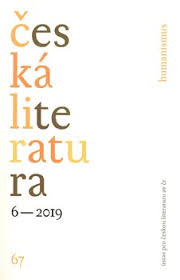Křesťanští Terentiové v českých zemích
Christian Terencians in the Czech lands
Antique inspiration in three Bohemical plays based on Tobit
Author(s): Magdaléna JackováSubject(s): Czech Literature
Published by: AV ČR - Akademie věd České republiky - Ústav pro českou literaturu
Keywords: humanist drama; biblical drama; Jesuit drama; Kyrmezer Pavel; Jan Aquila of Plaveč; Dingenauer Georgius
Summary/Abstract: This study is meant to be a first step towards a reflection of the concept of “humanist drama”, which has hitherto been missing in Czech theatre studies — “humanist” is a term applied to practically all dramas written during the humanist period, i.e. approximately from the mid-16th century to the Battle of the White Mountain. The author of this study bases herself on a definition by J. Parente, who considers any drama to be humanist if its structure and language are based on the Renaissance concept of Graeco-Roman theatre. Hence her study attempts to show the extent to which it is possible in Bohemical biblical plays from the pre-1620 period to detect antique inspiration, or to be more precise, the extent to which this inspiration is particularly reflected in its structure and secondary elements. It is with this intention that she compares three Bohemical biblical plays that share the theme of the Old Testament Book of Tobit: two in Latin (Tobaeus written by Jan Aquila of Plaveč in 1569 and Tobias Junior written by Jesuit Georgio Dingenauer in 1616) and one in Czech (Komedie o Tobiášovi written by Pavel Kyrmezer in 1581). These plays share not only the subject, but also the comic genre; the reason for this selection is primarily the predominance of comedy among Bohemical dramas of this period and the presumption that the dramatic output of the latter half of the 16th century is influenced more by Roman comediographs than Senecan tragedies. The author comes to the conclusion that out of all the dramas that she analyses the closest to antique models is Aquila’s comedy, although even here the inspiration of Roman comedy is very slight in comparison with other contemporary authors. Kyrmezer’s play is a typical representative of vernacular dramas: on the one hand it reveals the classical education of its author with stage notes in Latin, division into five acts and the existence of a prologue, but then the contents of the secondary elements and the structure of the plot make this drama quite contemporary. Georgius Dingenauer handles the secondary elements and the structure of the play in a completely different way to the two previous authors. His drama anticipates the transformation that Jesuit school dramas undergo by the early 18th century: with the secondary elements turning into scenes that are sung with the aim of elevating the plot from particular events to a universal level using allegorical figures.
Journal: Česká literatura
- Issue Year: 67/2019
- Issue No: 6
- Page Range: 827-848
- Page Count: 22
- Language: Czech

